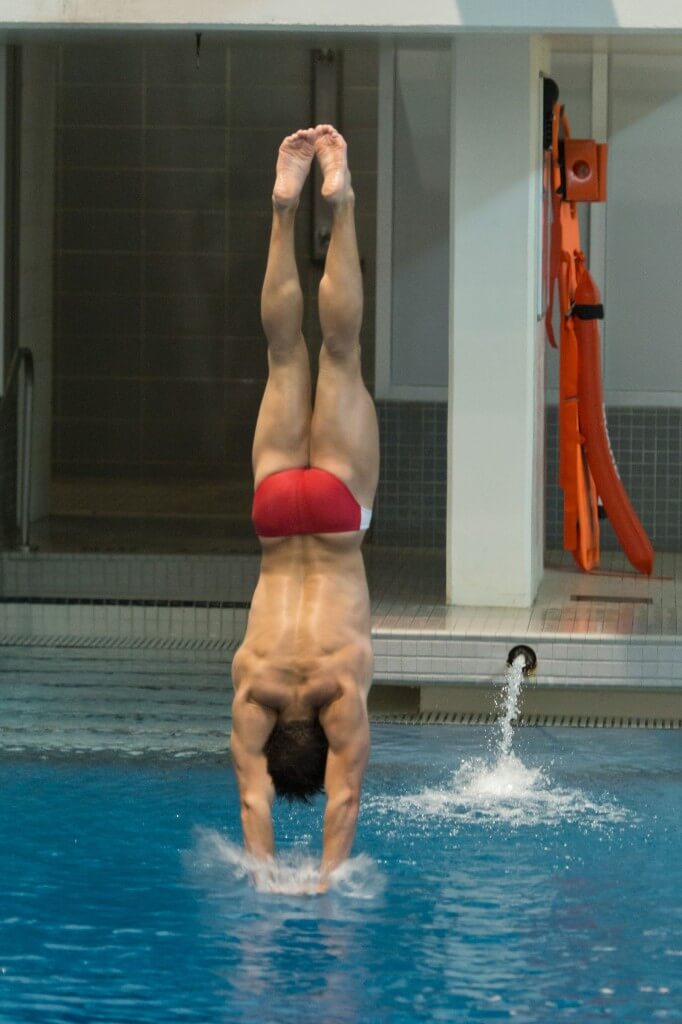Preventing Lower Back Injuries In Divers

Photo Courtesy: Matthew S. DeMaria
By G. John Mullen
SANTA CLARA – Competitive diving involves jumping from 1-, 3-, or 10-meter boards — as well as from cliffs even high than that — and doing somersaults and twists in the air before entering the water. Divers jumping from a 10-meter platform reach a velocity of 31.8 miles per hour before entering the water, and decelerate to 20.5 miles/hour upon impact, amounting to approximately 881.8 pounds of force upon impact with the water (Narita 2013). That’s a lot of stress on the body, particularly the lower back.
Researchers have found that lower back pain (LBP) is the most frequently reported symptom in divers, which we corroborated, in which the incidence of LBP in junior divers aged 13–17 was very high (38.4%). The specific types of lower back pain vary, from spondyloysis to non-specific lower back pain.
More on lower back pain, or Spondylolysis
It has been reported that a diver’s first back pain begins at a young age, likely during the growth spurt period (Baranto 2006). This high injury frequency and young age of incidence suggest an injury prevention program is necessary.
Narita (2013) discusses a four-step approach for injury prevention:
- Investigations for the injuries are implemented to understand the rate of incidence and the severity of trauma;
- The cause, mechanism and the risk factors for the injuries are determined;
- A prevention plan is introduced to counteract the risk factors;
- Post-implementation investigation is conducted to assess the effectiveness of the prevention plan.
Rate of Incidence of Lower Back Injuries in Divers
The Japanese Swimming Federation has been performing the first step of this four-step process, collecting data on injury rate and incidence from their national training camps from 2003 to 2011. During this time, LBP was investigated by interviewing and performing a physical examination conducted by a physical therapist to determine whether LBP was present, chronic and perceived by the diver. The physical therapists defined LBP as continuous pain of more than 12 weeks’ duration. The divers confirmed the presence of LBP during movement (lumbar, flexion and extension). This study found 37.3% of the divers reported LBP during the training camp. This study notes age significantly correlated with pain in both male and female divers, and shoulder rotation width correlated with LBP in the male divers.
This study confirms the high rate of low back pain in divers. These results also suggest that shoulder joint flexibility is important in competitive divers, and is a risk factor for LBP. The correlation between shoulder mobility and low back pain seems that if a diver lacks shoulder mobility (particularly on a reverse-position dive), then they compensate with more low back motion, increasing low back stress. This correlation likely lacked in female divers, as they demonstrate more shoulder mobility.
Cause, Mechanism and Risk Factors of Low Back Pain in Divers
The cause and mechanism of low back pain in diving requires more research, but overuse seems like the obvious culprit. In diving, you undergo thousands of spinal flexions, extensions, and rotations. This volume increases stress and increases the risk of injury.
Prevention Plan and Post Implementation
Clearly, eliminating low back stress during diving is nonsensical. However, low back prevention and frequent evaluation of prevention programs is very possible. If you or your team seriously wants to reduce the incidence of low back pain, it is important to work with a physical therapist for creating and monitoring a low back pain prevention model. Some prevention models should consider:
- Limiting spinal flexion and extensions during dryland
- Multiplanar core strengthening
- Individualized mobility programs
- Frequent injury assessments for low back pain
- Soft tissue rehabilitation
- Biomechanical analysis for diving and dryland
These are only a few things the physical therapist could implement. Take a deep breath, as this may seem overwhelming, but the simple addition of a few of these variables may drastically reduce low back pain on your diving team and increase enjoyment of diving for the entire team. Take a systematic approach, create a prevention program, evaluate the program and injury rate each year and enjoy the long-term success and enjoyment for years to come!
References:
Narita T, Kaneoka K, Takemura M, Sakata Y, Nomura T, Miyakawa S. Critical factors for the prevention of low back pain in elite junior divers. Br J Sports Med. 2014 Jun;48(11):919-23. doi: 10.1136/bjsports-2012-091875. Epub 2013 Apr 25.
Baranto A, Hellström M, Nyman R, Lundin O, Swärd L. Back pain and degenerative abnormalities in the spine of young elite divers: a 5-year follow-up magnetic resonance imaging study. Knee Surg Sports Traumatol Arthrosc. 2006 Sep;14(9):907-14. Epub 2006 Jan 17.




I completely agree that a full biomechanical analysis is appropriate for any professional diver. I have treated collegiate divers in my practice with low back pain and have found the great success rates in the patients that followed the regular home care stretching and core stabilization exercises that I prescribed. Good article and I hope that the divers reading this heed your advice and seek the care of a professional for their biomechanical/musculoskeletal complaints.
Thanks for the comment and personal experience. Keep up the good work!